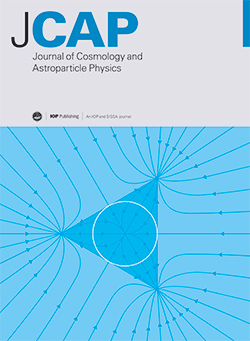IF 5.3
2区 物理与天体物理
Q1 ASTRONOMY & ASTROPHYSICS
Journal of Cosmology and Astroparticle Physics
Pub Date : 2025-03-11
DOI:10.1088/1475-7516/2025/03/018
引用次数: 0
摘要
我们通过数值计算发现,目前星系的可观测恒星特性与原始密度和潮汐场有很大关系。通过分析来自TNG300-1模拟的星系目录,我们首先计算了原始自旋因子τ,它被定义为原初密度主轴和原初银河系位置的势海斯张量主轴之间的平均错位程度。然后,我们在香农信息论的框架下探讨了当前星系的六种恒星属性(即两种恒星大小(R90⋆和 R50⋆)、年龄、特定恒星形成率、光学颜色和金属性)中的每一种属性是否以及在多大程度上与τ(在 z = 127 时测量)共享相互信息。我们故意控制TNG星系样本的质量、环境密度和剪切力分布没有差异,从而找出τ对每个星系恒星特性的净影响。在M⋆/(h-1M⊙)≥1010的较高恒星质量范围内,所有六种恒星性质都表现出与τ的大量互信息;而在M⋆/(h-1M⊙)<1010的较低恒星质量范围内,除了特定恒星形成率和颜色之外,六种性质中只有四种产生了与τ相关的显著信号。通过研究六种恒星性质的平均值是如何随τ而变化的,我们还发现,源自原银河系的星系,τ值越高,往往具有越大的尺寸、越晚的形成纪元、越高的特定恒星形成率、越蓝的颜色和越低的金属性。研究还发现,无论M⋆如何,星系恒星大小与τ的关系最为密切,遵循双峰伽马分布,并讨论了其中的物理含义。本文章由计算机程序翻译,如有差异,请以英文原文为准。
Dependence of galaxy stellar properties on the primordial spin factor
We present a numerical discovery that the observable stellar properties of present galaxies retain significant dependences on the primordial density and tidal fields. Analyzing the galaxy catalogs from the TNG300-1 simulations, we first compute the primordial spin factor, τ, defined as the mean degree of misalignments between the principal axes of the initial density and potential hessian tensors at the protogalactic sites. Then, we explore in the framework of Shannon's information theory if and how strongly each of six stellar properties of the present galaxies, namely two stellar sizes (R90⋆ and R50⋆), ages, specific star formation rates, optical colors and metallicities, share mutual information with τ, measured at z = 127. Deliberately controlling the TNG galaxy samples to have no differences in the mass, environmental density and shear distributions, we single out net effects of τ on each of the galaxy stellar properties. In the higher stellar mass range of M⋆/(h-1M⊙)≥ 1010, significant amounts of mutual information with τ are exhibited by all of the six stellar properties, while in the lower range of M⋆/(h-1M⊙) < 1010 only four of the six properties except for the specific star formation rates and colors yield significant signals of τ-dependence. Examining how the mean values of the six stellar properties vary with τ, we also show that the galaxies originated from the protogalactic sites with higher τ values tend to have larger sizes, later formation epochs, higher specific star formation rates, bluer colors and lower metallicities. It is also discovered that the galaxy stellar sizes, which turn out to be most robustly dependent on τ regardless of M⋆, follow a bimodal Gamma distribution, the physical implication of which is discussed.
求助全文
通过发布文献求助,成功后即可免费获取论文全文。
去求助
来源期刊

Journal of Cosmology and Astroparticle Physics
地学天文-天文与天体物理
CiteScore
10.20
自引率
23.40%
发文量
632
审稿时长
1 months
期刊介绍:
Journal of Cosmology and Astroparticle Physics (JCAP) encompasses theoretical, observational and experimental areas as well as computation and simulation. The journal covers the latest developments in the theory of all fundamental interactions and their cosmological implications (e.g. M-theory and cosmology, brane cosmology). JCAP''s coverage also includes topics such as formation, dynamics and clustering of galaxies, pre-galactic star formation, x-ray astronomy, radio astronomy, gravitational lensing, active galactic nuclei, intergalactic and interstellar matter.
 求助内容:
求助内容: 应助结果提醒方式:
应助结果提醒方式:


